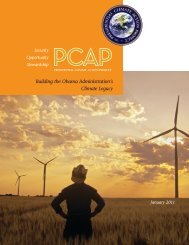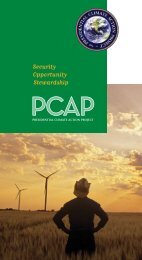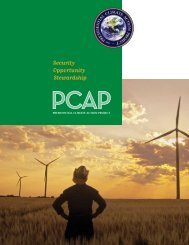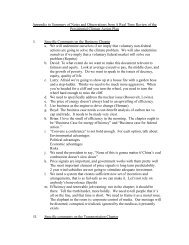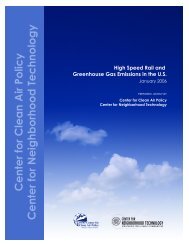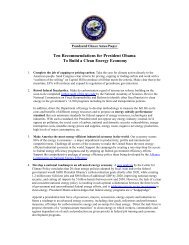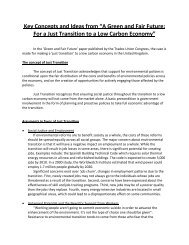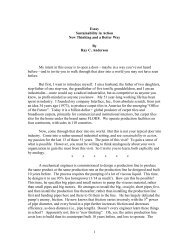Declare that it is the responsibility of the federal government to protect the atmosphereand related natural systems as a global commons and public trust. Declare that protectionof the atmosphere is a principal duty of federal program managers and incorporate thatresponsibility into managers’ performance standards and ratings.C-3The President should issue a declaration that the atmosphere is a global commons whosebenefits and obligations for stewardship extend to all Americans, present and future. . . . While adeclaration of the commons would not have the force of law, it would establish and make visiblea principle that should govern domestic and international policy in the years ahead – therecognition of our obligation to protect the resources on which all people depend. <strong>PCAP</strong> Report2:2-3.The President should issue these directives . . .• The President should establish the policy that all elected and agency officials are trusteesof resources owned by the American public. The President should direct agency officialsto approach climate security as a national security priority and to use their authoritiesand resources to protect the ecological trust. <strong>PCAP</strong> Report, 9:4.Generally. There are two parts to this proposal: (1) declaring that the atmosphere is a globalcommons that should be protected; and (2) declaring that it is the responsibility of federalemployers to protect the atmosphere as a global commons (or public trust) and incorporating thatresponsibility into performance standards and ratings.In regard to the first part of the proposal, the declaration to the general public is aspirational. Asproposed in the <strong>PCAP</strong> Report it will have no legal effect. By convention, directives that areissued to those outside the government are issued as presidential proclamations; executive ordersare directed to officials within the government. 315 In addition, proclamations are better suited foraspirational directives. 316 Presidents frequently combine directive tools to implement policies.For example, for this proposal a presidential proclamation could be used for the first part of theproposal, directed to the public, and an executive order for the second part directed to federalagencies and referencing the proclamation.In terms of the second part of this proposal, incorporating protection of the atmosphere into theduties of federal program managers and translating that into performance standards and ratings,the President has significant authority over the performance appraisal system for federalemployees. It is not uncommon for a president to issue an executive order establishing ordeclaring a federal policy and directing that agencies incorporate corresponding duties intoperformance standards (or establishing an award system for successful implementation of the315 See Boundaries Report, Chapter II(1), (2).316 See, e.g., Section I of this report (proclamation section).CEES 83 | P age
policy). Performance standards must be based on objective criteria; thus, any principle uponwhich they are based must be clearly defined.The first part of this analysis identifies supporting authority for the declaration. Although thedeclaration is aspirational, grounding it in authority lends credibility and legitimacy to thedirective. Further, it bears on the second part of this proposal as the declaration will also be usedas the basis for an order to federal agencies to establish duties and performance standards ofprogram managers.3.1. Declaring that the Atmosphere is a Global Commons that should be ProtectedBackground. There is no statute that establishes this principle explicitly. However, it is notuncommon for executive orders to be issued “in furtherance of” or “to reaffirm and strengthen” apolicy, principle or duty, and a policy or duty contained in a statute carries the most weight. 317Executive orders are also sometimes issued “consistent with” statutory authority. 318 There is acogent, supportable argument that the policy contemplated by this proposal does not contradictthe will of Congress and is, in fact, in furtherance of Congress’ will as has been expressed innumerous statutes over time. A review of some of these statutes follows below.Statutes. The following is a review of selected statutes that support the principle contemplatedby this directive. This evaluation is organized into three sections: (1) statutory provisions thatestablish a purpose, mission, goal, finding or declaration of national policy directly supportingthis proposal (e.g., it is traditionally or explicitly inclusive of air pollution or climate change); (2)statutory provisions with the purpose, mission, goal, finding or declaration of national policy thatprimarily regard something other than the air or the atmosphere; however, protection of theatmosphere would be an inherent part of the strategy necessary to address the mission or goal ofthe law; and (3) statutory provisions that this declaration is “consistent with.” There arenumerous statutes that could be included in each of these categories; we highlight here some ofthe most significant as examples of supportive authority.317 See, e.g. Exec. Order No. 11987, Exotic Organisms, (May 24, 1977) (“. . . in furtherance of the purposes andpolicies of the Lacey Act . . . and the National Environmental Policy Act of 1969, . . .it is hereby ordered as follows. . . .”); Exec. Order No. 13157, Increasing Opportunities for Women-Owned Small Businesses, (May 23, 2000) (Inorder to reaffirm and strengthen the statutory policy contained in the Small Business Act, it shall be the policy of theexecutive branch to take the steps necessary to …”).318 E.g., Exec. Order No. 12114, Environmental Effects Abroad of Major Federal <strong>Action</strong>s, (Jan. 4, 1979) (“in orderto further environmental objectives consistent with the foreign policy and national security policy of the UnitedStates, it is ordered as follows . . . .”).CEES 84 | P age
- Page 1 and 2:
THE BOUNDARIES OF EXECUTIVE AUTHORI
- Page 4 and 5:
This page left intentionally blank.
- Page 6 and 7:
Proposal IndexPage NumberA Establis
- Page 8 and 9:
D-01 Direct the federal Climate Cha
- Page 10:
I. IntroductionThis report is a fol
- Page 16 and 17:
• The President shall not substit
- Page 18 and 19:
42, Chapter 77, Subchapter III expl
- Page 20 and 21:
In addition, it delegates to the Pr
- Page 22 and 23:
C. Presidential ProclamationsThere
- Page 24 and 25:
2. The developed country Parties an
- Page 26 and 27:
A. Establish National Energy and Ca
- Page 28 and 29:
the Nation, paying particular atten
- Page 30 and 31:
The President should establish the
- Page 32 and 33:
The President should establish the
- Page 34 and 35:
This proposal is framed in terms of
- Page 36 and 37:
partnership is working to reduce me
- Page 38 and 39:
Good candidate to implement by exec
- Page 40 and 41:
Executive Orders. There are 30 exec
- Page 42 and 43: Congress annually a comprehensive r
- Page 44 and 45: The Rural Utilities Services (RUS)
- Page 46 and 47: through the energy policy, has some
- Page 48 and 49: Direct the EPA to work with the Chi
- Page 50 and 51: private members: E.O. 12216, the Pr
- Page 52 and 53: next 20 years.” 181 From the publ
- Page 54 and 55: Direct the EPA to immediately begin
- Page 56 and 57: scientific judgment.” 199 Further
- Page 58 and 59: Direct the EPA to immediately grant
- Page 60 and 61: of climate change in California are
- Page 62 and 63: Direct the EPA and DOE to collabora
- Page 64 and 65: The ATA is a private entity, and as
- Page 66 and 67: and Bioenergy, establishes an inter
- Page 68 and 69: Authority over the Entities Subject
- Page 70 and 71: Direct the DOT to reconvene the Cli
- Page 72 and 73: Direct NASA to restore earth scienc
- Page 74 and 75: Direct the Council on Environmental
- Page 76 and 77: C. Improve Federal StewardshipDirec
- Page 78 and 79: 3. Background.OMB performs legislat
- Page 80 and 81: There are numerous executive orders
- Page 82 and 83: Federal Energy Management Executive
- Page 84 and 85: 1973; (3) E.O. 12845, Requiring Age
- Page 86 and 87: This proposal is consistent with an
- Page 88 and 89: 4. GHG reduction goals to transport
- Page 90 and 91: President, but the President “may
- Page 94 and 95: 1. Statutory provisions that establ
- Page 96 and 97: whenever feasible; and disposal or
- Page 98 and 99: species is listed as a threatened s
- Page 100 and 101: Determination of priorities which a
- Page 102 and 103: 3.2 Declaring that it is the respon
- Page 104 and 105: Management, (June 3, 1999) includes
- Page 106 and 107: economic, and other requirements of
- Page 108 and 109: environment.” Based on the polici
- Page 110 and 111: D. Protect American Taxpayers from
- Page 112 and 113: special committees but are expressl
- Page 114 and 115: Direct the federal Climate Change S
- Page 116 and 117: The CCSP is an executive branch age
- Page 118 and 119: E. Mobilize the MarketplaceDirect t
- Page 120 and 121: pollutants. Further, courts give gr
- Page 122 and 123: Direct the Council on Environmental
- Page 124 and 125: methods, and data related to sustai
- Page 126 and 127: F. Build Public-Private Partnership
- Page 128 and 129: printed in the Federal Register and
- Page 130 and 131: that officer or employee. Advisory
- Page 132 and 133: A-06A-07B-01B-02B-03B-04B-05B-06B-0
- Page 134 and 135: C-02.7C-02.8C-02.9C-03C-03.1C-03.2C
- Page 136 and 137: Appendix AStatutes with Specific Te
- Page 138 and 139: (C) assess the potential for the de
- Page 140 and 141: 15 U.S.C.A. § 657hTitle 15. Commer
- Page 142 and 143:
(5) Climate fluctuation and change
- Page 144 and 145:
(4) global data collection, and mon
- Page 146 and 147:
15 U.S.C.A. § 2932§ 2932. Committ
- Page 148 and 149:
implementation of any Federal actio
- Page 150 and 151:
(2) Projects eligible for funding u
- Page 152 and 153:
emissions associated with each type
- Page 154 and 155:
22 U.S.C.A. § 7902§ 7902. Reducti
- Page 156 and 157:
(c) Performance reviews and reports
- Page 158 and 159:
(3) Priority for integrated gasific
- Page 160 and 161:
[It is the purpose of this chapter
- Page 162 and 163:
(i) that no low greenhouse gas emit
- Page 164 and 165:
(3) prepare and transmit to the Con
- Page 166 and 167:
42 U.S.C.A. § 13384§ 13384. Asses
- Page 168 and 169:
(i) Selection of projects(3) In sel
- Page 170 and 171:
(1) In generalThe Secretary, in con
- Page 172 and 173:
(b) GoalsThe program shall have the
- Page 174 and 175:
Subchapter II. Energy Security thro
- Page 176 and 177:
Subchapter IV. Energy Savings in Go
- Page 178 and 179:
(B) to reduce emissions of covered
- Page 180 and 181:
§ 17334. Actions by overseas priva
- Page 182 and 183:
(5) be committed to minimizing admi
- Page 184 and 185:
Appendix BProclamations that Addres
- Page 186 and 187:
8) Proc. 7150, Nov. 20, 1998, World



